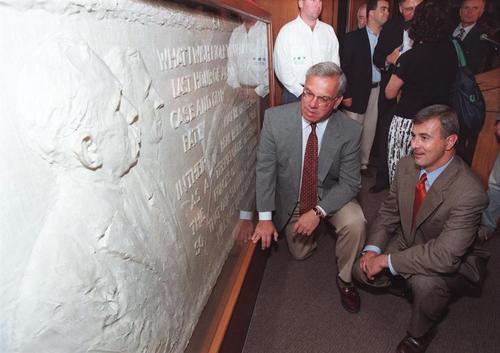

11/01/2017
Livin' In A World Of Fools. As I prepare to post this diary, on the morning of November 1st, the news is dominated by a terrorist attack in New York City. A crazy Muslim, admitted for settlement in the U.S.A. under the craziest of our crazy immigration laws, murdered eight people using a rented truck.
Reporting in last week’s podcast on the October 22nd election in Japan, I said the following thing:
The great ructions over globalism, nationalism, multiculturalism, and mass immigration that are driving anti-establishment feeling in the West just aren’t in play in Japan. The Japanese electorate can concentrate their attention on other matters: energy policy, national defense, social security, the economy.It sounds nice, doesn’t it? A real nation, of people who know who they are, trying collectively to cope with unavoidable political issues — not with horrible problems they have blindly, stupidly, unnecessarily brought upon themselves via ethnomasochism and sentimental fantasies about human nature.
I have of course said and written similar things before — many, many times. Have I said that the most astonishing statistic of the 21st century, in my opinion, is that our country admitted more Muslims for settlement in the fifteen years after 2001 than we did in the fifteen years prior? Yes I have; at least three times, according to a quick search of the archives.
Those of us who have eyes to see and voices to sound the alarm with can only repeat things we said or wrote years, sometimes a decade or two, ago. Even a writer as resourceful and ingenious as Mark Steyn is reduced to cutting'n'pasting from stuff he wrote early in the last decade.
That’s the problem with stating the blindingly obvious; having stated it, there’s nothing much to do but state it again, hoping that with enough repetitions it might sink in.
Meanwhile the public sphere lurches from hysteria to hysteria. Last month it was Confederate statues; this month it’s, what? Oh yes: "sexual harassment."
I am old enough to remember — it was less than thirty years ago — when Sweden’s runaway feminism was a standing joke with other Europeans. You stepped on a woman’s toe in a crowded elevator; you apologized; she waved it away with a smile; someone said, "That’s rape in Sweden!" and everyone laughed.
Nobody’s laughing now. Indeed, I wonder for how much longer laughter will be allowed.
If you deduce from all that that I’m suffering from Bloviator Fatigue, your deduction is valid.
"Against stupidity, the Gods themselves struggle in vain," said Schiller.
"What is life … but a long dialogue with imbeciles?" asked Pierre Ryckmans rhetorically.
They were both right (a rhetorical question is really an assertion). Fortunately for our sanity we still, for a while longer, have the private sphere to retreat to — the comforts, satisfactions, and occasional joys of home, family and friends. That’s the sphere that my thoughts and feelings have mainly been dwelling in this month.
When Danny comes marching home. Much joy in the Derb household the last week of October: Our son Danny came home having served four years in the U.S. Army as a paratrooper. (Pictured right heading for for infantry training in 2013, and in mid-air over Alaska.)
I'd like to express my heartfelt gratitude to the Army for having turned an ornery teenager into a confident, capable, courteous American gentleman. I don’t know how you did it, but: Thank you!

Looking through Danny’s discharge papers, I was struck by the impressive number of military decorations he acquired, without even — to his chagrin — ever having been deployed to a combat zone. Here’s the list:
Armies everywhere bestow a certain number of decorations just for showing up. In the trenches of WW1 the Tommies used to say this kind of award "came up with the rations." So far as I can figure, the last five on the list are of that kind. Numbers one and two have to be earned, though. We're proud of our son for having earned them.
(I was puzzled by that Overseas Service Ribbon. "When were you overseas?" I asked Junior. He: "Alaska counts as overseas." Really? Seems odd to me, but I’m in no mood to argue with the Army — see above.)
Traces of habitation. I apologize for this month’s diary being somewhat skimpy. As well as the dislocation and excitement of having our son home, I've been busy with construction work. The two things are related.
We have been in our suburban house (advertised to us in the original 1991 realtor’s brochure as a "charming Dutch Colonial home") for twenty-five years, and have raised two kids in it. We love the house, our garden, the neighborhood, our neighbors (well, most of them), and our town, and we have no intention of moving.
The only downside to all this settled contentment is that the house has silted up with junk. Out attic and basement are totally full of things we shall likely never want, but for one reason or another don’t want to throw out.
We have a standalone two-car garage. It has a loft. My big home-maintenance project last year was fixing up the loft, so that we could use it for storage space. That went well; but it’s three-quarters full already with overflow from the house.
Danny tells us that in four years on base, he’s accumulated a mass of stuff. The Army is shipping it over from Alaska to us, estimated travel time "two to six weeks." More storage space needed!
So I've spent this month giving the downstairs of the garage a makeover — its first, I believe, since it was built eighty-something years ago. I have ripped out the crumbling old drywall; re-drywalled; spackled; added woodwork; painted; hung overhead storage; … I've been busy.
Sentiment kicked in. Our house was built in the 1930s by a Swedish carpenter named Albert Pearson (Pearsen? Petersen? I’m relying on my memory of what elderly neighbors told us 25 years ago). He actually built the garage first, then lived there with his wife and kids while he built the house.

In one corner of the garage some evidence of this domestic period has survived. High up on the ancient drywall some scraps of the family’s original wallpaper remain.
I couldn’t bring myself to remove those traces of long-ago family life, so I've left that corner intact, as a wee tribute to the man who built my house back in the Hoover administration. Thanks, guy.
Great Progressive Causes Of Yesteryear. A violent storm hit Long Island the last weekend of October. That Sunday we drove half an hour in pelting rain to a wake. It was a neighbor: a young man, only 28 years old, who had died from leukemia. May the poor fellow rest in peace.
Driving through that storm, I couldn’t help thinking of Edna St. Vincent Millay’s memorable line: "We shall die in darkness, and be buried in the rain."
That line is from a poem protesting against the execution of anarchists Sacco and Vanzetti in August 1927. Millay was a bohemian progressive; the Sacco-Vanzetti case — the case, that is, that they were innocent of the murders they were sentenced for — was a great progressive cause of the 1920s.

I didn’t notice any 90th-anniversary commemorations of the execution in August; possibly Sacco and Vanzetti were too white and male for today’s progressives to go on caring about. (The sculpture at left was unveiled by Boston Mayor Thomas Menino in 1997 — the 70th Anniversary.)
And please don’t ask me for a clear opinion about whether Sacco and Vanzetti were guilty. The case has been chewed over for decades, every scrap of evidence examined, re-examined, and re-re-examined. Unless you've read that mountain of material, you're a mere amateur.
My temperamental bias is to assume they were guilty, just on the basis that most things progressives get passionate about are bogus. Still, stopped clocks are right twice a day. Who knows?
Art And Politics. I am a strong believer in the idea that really good writers, musicians, artists, athletes, and other performers at the highest levels of skill should be given a pass for having silly opinions about things not connected with their art.
George Orwell said of Evelyn Waugh that: "Waugh is about as good a novelist as one can be … while holding untenable positions." I’m a bit warmer than that. I doubt Waugh would have been any better a novelist if he had somehow acquired a totally different set of opinions, any more than Yeats would have been a better poet without all the occultist buncombe, or Shelley without his radical enthusiasms.
So with Edna St. Vincent Millay. If your knowledge of her progressivism interferes with your admiring luminously beautiful sonnets like this one, you are taking politics much too seriously:
Even in the moment of our earliest kiss,When sighed the straitened bud into the flower,
Sat the dry seed of most unwelcome this;
And that I knew, though not the day and hour.
Too season-wise am I, being country-bred,
To tilt at autumn or defy the frost:
Snuffing the chill even as my fathers did,
I say with them, "What’s out tonight is lost."
I only hoped, with the mild hope of all
Who watch the leaf take shape upon the tree,
A fairer summer and a later fall
Than in these parts a man is apt to see,
And sunny clusters ripened for the wine:
I tell you this across the blackened vine.
Graph of the month. Of last month, actually; but worth noting.

This is from Steve Hsu at Infoproc, a post titled "Accurate Genomic Prediction Of Human Height." That’s what the picture shows: The actual heights of 2,000 individuals plotted against the height predicted from a scrutiny of each individual’s genome.
It’s not strictly speaking a graph, but a scatter plot. Each little blob is one of those individuals. As you can see, "guessing" a person’s height from his genome, by scrutinizing around 20,000 single-nucleotide (A, G, C, or T) locations, is fairly accurate.
Steve:
The big picture implication is that heritable complex traits controlled by thousands of genetic loci can, with enough data and analysis, be predicted from DNA. I expect that with good genotype | phenotype data from a million individuals we could achieve similar success with cognitive ability.
As Charles Murray says: There’s a locomotive coming down the tracks.
Book Of The Month Not much time for reading this month, but I did take in Jared Taylor’s If We Do Nothing.
It’s an essay collection, reprints of 37 pieces Jared has written at various times over the past twenty-odd years. A couple of things occurred to me while reading.
First, the pieces have aged well — better than mine covering some of the same ground across the same time span. Except where the subject matter is topical — the Hurricane Katrina pieces from 2005, for instance — it’s hard to date these essays from internal evidence.
Second, Jared is a really good writer: thoughtful, literate, witty, punctilious about usage. He actually has a whole chapter on the silly usages foisted on us by feminists:
Every day, the left is hacking away at the language. Fight back. Proudly use such sentences as: "Since man is a mammal, he suckles his young."
It makes me grind my teeth to think that an illiterate, humorless poseur like Ta-Nehisi Coates can storm the best-seller lists with his blackety-black gibberish while Jared’s clear thinking, good writing, and calm, fair-minded acceptance of racial reality languish in obscurity. Truly it has been said: Gold sinks but poop floats.
I'll admit I’m a Taylor groupie. Jared is a great man, who will be remembered long after I (surely), you (probably), and the fools and mountebanks who occupy our attention today are all forgotten.
In the spirit of proper objective criticism, though, I should try to find some faults in the book. OK, here’s one, though a slight and debatable one.
It’s in the 1996 essay "The Ways of our People," in which Jared tackles the question that, really, is at the heart of his concerns: What the hell is the matter with white people? Why do we, alone of all the world’s people, strive to engineer our own replacement?
The essay begins, though, by sketching some characteristically white patterns of thought and behavior. Among them Jared includes sportsmanship:
The swaggering, "trash talk," corner cutting, and absence of gentlemanly play common in sports today are largely the importation of non-white behavior into a previously white arena. Sadly, many whites have been affected and act just as loutishly.
I refer Jared to my comments on the inauguration of President Trump back in January, when I pulled in Confucius for a reference:
The Master said: Exemplary people do not compete with one another. The nearest exception is the Archery Ceremony. Greeting and accommodating each other, the archers mount the stairs of the hall. Descending after contesting, they share a drink together. Even when competing they remain exemplary people. [Analects 3.vii.]
Apparently civilized sportsmanship was going strong in old China 2,500 years ago. Not all civilized behaviors are exclusive to whites.
Reading Trollope in Manchuria. I was glad to see that Jared is a fellow Trollope fan. I've read a fair bit of Trollope, though not as much as I want to. One of the items on my bucket list is to have read all 47 of the novels before I go.

My most memorable engagement with Trollope was in China, 1983. I had booked to fly from Changchun, in far northeast China, to Hong Kong for the Lunar New Year. Civilian air travel was a new thing in China back then, though, and the planes didn’t fly unless the weather was perfect. That particular day it wasn’t, so I was stuck the whole day in that cruddy provincial ChiCom airport — really just a shed — waiting for a change of weather.
All I had to read was Trollope’s The Way We Live Now, which I'd borrowed hastily as I was leaving from the random selection of Eng. Lit. classics in the library of the college I taught at. I read the whole thing. If not for Trollope, I might have perpetrated a plane hijacking.
It was an apt choice, too: the Emperor of China has a walk-on part in the novel.
Math Corner. Here is a brainteaser that, I am assured (haven’t tried it myself yet), can be solved using standard high school real functions that appear on every scientific calculator.
I have a circular paper disk. I draw two radii, the lesser angle between them being α (the greater angle is of course 360 degrees minus α).
Then I cut along these radii, giving me two pieces of paper, each of which can be rolled up, radius joining radius, to make a circular cone.
What value of α should I use to maximize the total volume of these two cones?
John Derbyshire writes an incredible amount on all sorts of subjects for all kinds of outlets. (This no longer includes National Review, whose editors had some kind of tantrum and fired him. ) He is the author of We Are Doomed: Reclaiming Conservative Pessimism and several other books. He has had two books published by VDARE.com com:FROM THE DISSIDENT RIGHT (also available in Kindle) and FROM THE DISSIDENT RIGHT II: ESSAYS 2013.
For years he’s been podcasting at Radio Derb, now available at VDARE.com for no charge.His writings are archived at JohnDerbyshire.com.
Readers who wish to donate (tax deductible) funds specifically earmarked for John Derbyshire’s writings at VDARE.com can do so here.
This is a content archive of VDARE.com, which Letitia James forced off of the Internet using lawfare.